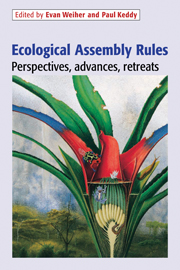Book contents
- Frontmatter
- Contents
- List of Contributors
- Introduction: The scope and goals of research on assembly rules
- Part I The search for meaningful patterns in species assemblages
- Part II Other perspectives on community assembly
- 8 On the nature of the assembly trajectory
- 9 Assembly rules as general constraints on community composition
- 10 A species-based, hierarchical model of island biogeography
- 11 Interaction of physical and biological processes in the assembly of stream fish communities
- 12 Functional implications of trait–environment linkages in plant communities
- 13 When does restoration succeed?
- 14 Epilogue: From global exploration to community assembly
- Index
8 - On the nature of the assembly trajectory
Published online by Cambridge University Press: 04 September 2009
- Frontmatter
- Contents
- List of Contributors
- Introduction: The scope and goals of research on assembly rules
- Part I The search for meaningful patterns in species assemblages
- Part II Other perspectives on community assembly
- 8 On the nature of the assembly trajectory
- 9 Assembly rules as general constraints on community composition
- 10 A species-based, hierarchical model of island biogeography
- 11 Interaction of physical and biological processes in the assembly of stream fish communities
- 12 Functional implications of trait–environment linkages in plant communities
- 13 When does restoration succeed?
- 14 Epilogue: From global exploration to community assembly
- Index
Summary
Introduction
Assembly is a basic device of nature where a broad range of entities, spanning many levels of scale, interact across time and space to produce oberserved pattern. Entities such as individuals, phenotypes, populations, guilds, and higher levels of organization like hierarchical structures are all subject to the processes of assembly. Because all biological systems are assembled in a dynamical sense, any generality in the process would prove valuable to our understanding of nature. Arguably, such an understanding is essential to fully appreciate the action of mechanisms as they are played out in evolutionary and ecological time.
Community assembly is ultimately driven by the invasion (e.g., speciation, immigration) and extinction of species played out against a complex background of environmental constraint. While the environment acts as a filter, eliminating some species and promoting others, it also provides spatio-temporal complexities which serve as a resource upon which ecological strategies can be built. Assembly processes and rules which operate within one environment may exhibit entirely different outcomes as a function of even minor environmental variation. Despite such obvious descriptions of the course of nature, the essence of the assembly trajectory remains little more than an elusive metaphor. Here, the character of the assembly trajectory is evaluated and a general framework offered which serves to interface the operation of ecological mechanisms and the mechanics of community assembly within the more general realm of complex systems.
- Type
- Chapter
- Information
- Ecological Assembly RulesPerspectives, Advances, Retreats, pp. 233 - 250Publisher: Cambridge University PressPrint publication year: 1999
- 16
- Cited by



